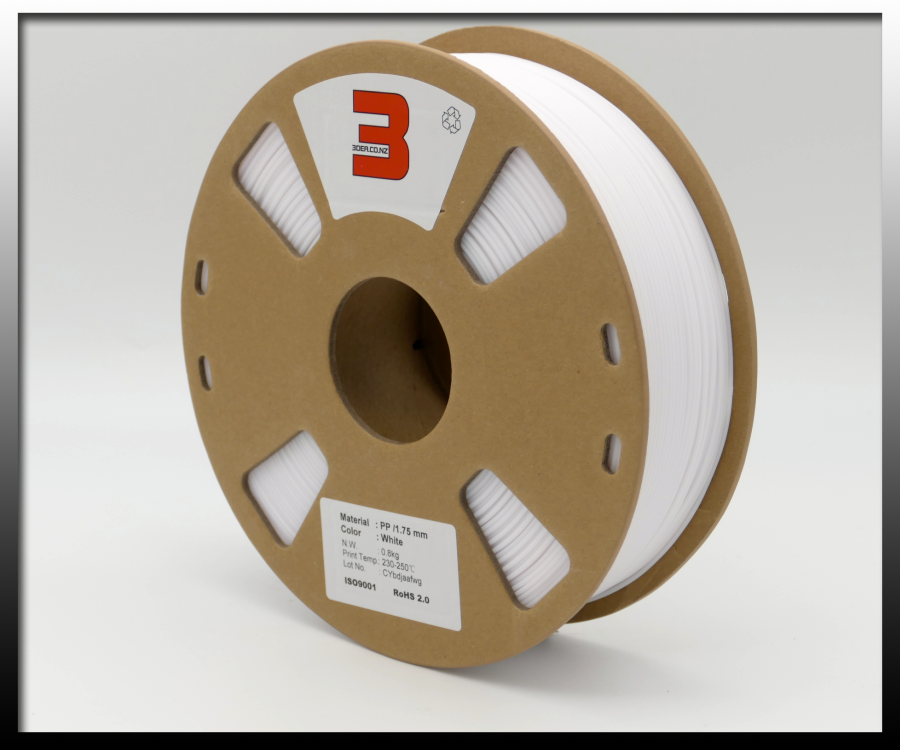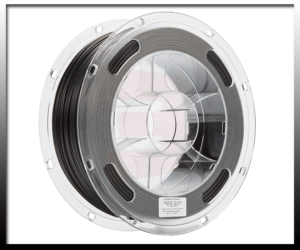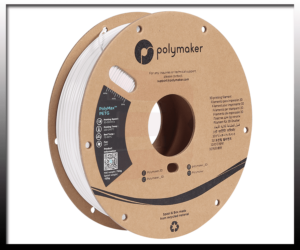Shop » Engineering (PLA ST/HS, PP, POM,..) » PP – White 1.75mm Polypropylene Filament
PP – White 1.75mm Polypropylene Filament
$59.90
Parts printed with PP filament are chemically resistant and suitable for applications in temperatures up to 100°C, and down to -20°C. Known for its low moisture absorption, PP maintains good resistance to chemicals and water up to 80°C, making it ideal for durable, flexible parts requiring thermal stability and impact strength.
0.8kg - White
Out of stock
Enhance your 3D printing capabilities with our Polypropylene (PP) 3D Printing Filament. This 1.75mm, 1kg filament offers the perfect blend of flexibility and stiffness, available in black and white. Polypropylene, a widely utilized plastic globally, is renowned for its significant presence in food contact and preparation applications, including milk bottles, owing to its exceptional chemical resistance and safety for food contact and medical applications.
Notably cost-effective, our PP filament delivers chemical resistance comparable to advanced materials such as PEI and PEEK, but at a fraction of the cost. This makes it an ideal choice for a wide range of projects that require both performance and affordability.
To ensure successful 3D printing with Polypropylene, we recommend using a closed-frame 3D printer, with active chamber heating strongly advised to manage the material’s cooling and adhesion properties. To counteract its tendency to shrink and poor adhesion to standard build surfaces, apply several layers of PP packaging tape to your print bed, followed by a minimal amount of glue. Print the first layer slowly and thickly, avoiding the use of cooling fans to ensure optimal adhesion and print quality.
For optimal printing conditions, start with an extruder temperature of 225°C and a bed temperature of 75°C, preparing the bed with clear PP packaging tape and glue as described. Similar to printing TPU materials, managing PP’s oozing and retraction characteristics is crucial for achieving water-tight prints and avoiding under-extrusion. Temperature management is key; too high and the filament may block in the throat, too low and it risks under-extrusion and delamination. Embrace slow print speeds and consider part design carefully to overcome challenges with thin walls and overhangs.
Finally, allow the PP part to cool down slowly after printing, without removing it from the bed immediately, to prevent shrinkage and warping. Utilizing Active Chamber Control, with the build plate turned off and the chamber maintained at 45°C, can significantly enhance the quality of your Polypropylene prints, ensuring they maintain their form and function post-printing. Embrace the potential of Polypropylene filament for your 3D printing needs, where durability meets affordability in every spool.
How to print:
- Printer Bed Preparation:
- Use a heated bed to improve first-layer adhesion. Bed temperature should be around 75°C to 85°C.
- Apply polypropylene (PP) tape or a similar adhesive surface to the print bed to enhance adhesion. Some users also recommend applying a layer of glue stick on top of the PP tape for even better results.
- Extruder Temperature:
- The extruder temperature for PP filament typically ranges from 225°C to 250°C. Start at 230°C and adjust based on your printer’s performance and the filament brand.
- Printing Speed:
- Print slower than you would with more common filaments like PLA or ABS. A speed of 30-50 mm/s is recommended for most parts, with even slower speeds for the initial layer to ensure good bed adhesion.
- Cooling:
- PP filament prints best with minimal to no cooling. Turn off the cooling fan or use it sparingly, only if necessary, to prevent warping and ensure proper layer adhesion.
- Retraction Settings:
- Due to PP’s tendency to ooze, fine-tuning retraction settings is crucial. Start with a minimal retraction distance and speed, then adjust based on the performance of your printer and the specifics of your print. This helps avoid issues like stringing and oozing.
- Layer Height:
- A layer height of 0.2 mm is a good starting point for PP filament. Adjust based on the desired balance between print speed and surface quality.
- Nozzle:
- Use a standard nozzle size, such as 0.4 mm, but ensure it is clean and in good condition to prevent clogging due to PP’s flow properties.
- Print Bed Adhesion:
- In addition to using PP tape, some users recommend a brim or raft to help with bed adhesion and to counteract warping.
- Post-Print Cooling:
- Allow the print to cool down slowly on the print bed to minimize warping and shrinking. Do not remove the print immediately after printing.
- Enclosure:
- Using an enclosed printer or creating an enclosure around your printer can help maintain a stable temperature around the print, reducing warping and improving print quality.
Remember, these settings are starting points, and optimal settings can vary between printers, and individual prints. It may take some experimentation to find the best settings for your specific setup and printing needs.
| Weight | 0.8 kg |
|---|---|
| Dimensions | 210 × 210 × 50 cm |
| Brand | |
| Colour | White |
1 review for PP – White 1.75mm Polypropylene Filament
Related products
- Quick ViewAdd to cart DetailsBuy Now
Fiberon PA12-CF10 is a premium carbon fiber reinforced long-chain copolyamide filament designed for demanding 3D printing applications. Engineered to combine excellent mechanical properties with low moisture sensitivity, this filament outperforms typical PA6/66 and PA6-based materials, offering greater dimension stability and improved surface finish. With the added benefits of Warp-free™ technology, fast printing, and high printer compatibility, Fiberon PA12-CF10 is the perfect choice for professionals seeking high-performance results at an affordable price.
- Quick ViewAdd to cart DetailsBuy Now
Parts made from this POM 3D printer filament are heat resistant to 100°C (continuous operating temperature) and can withstand low temperatures to -40°C. Overall, POM filament is known for its chemical resistance and good hydrolysis resistance up to approx. 60°C.
- Quick ViewAdd to cart DetailsBuy Now
PolyMax™ PETG offers better mechanical properties than any other regular PETG making it a good candidate for a wide range of applications.
- Quick ViewAdd to cart DetailsBuy Now
Polymaker PC-ABS is a PC/ABS polymer blend which offers excellent toughness and heat resistance while displaying good surface finish and good compatibility with metal plating.







The PP material :
1. works better than either Nylon or PC in the task of making a snap clip.
2. is not as stiff/brittle (as PA, PC) and less inclined to break off.
3. produces a 'reasonable' surface finish (although not perfect when supports are used).
This type of material has well known issues adhering to the standard PEI covered bed plates. I found two solutions that work:
1. Use common PP clear packaging tape applied to a smooth PEI bed plate.
2. Use MagiGoo Printing Adhesive liquid applied directly to any of the Smooth, Textured or Satin Bed plates. It's easier and quicker to apply, more convenient than the tape. I did try the "Printlock" product also, but it does not work with PP. Regular Korex paper glue does not work at all.